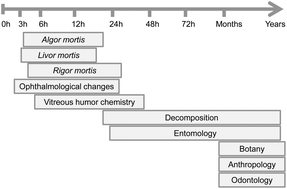Promising blood-derived biomarkers for estimation of the postmortem interval†
Abstract
A precise estimation of the postmortem interval (PMI) is one of the most important topics in forensic pathology. However, the PMI estimation is based mainly on the visual observation of cadaverous phenomena (e.g. algor, livor and rigor mortis) and on alternative methods such as thanatochemistry that remain relatively imprecise. The aim of this in vitro study was to evaluate the kinetic alterations of several biochemical parameters (i.e. proteins, enzymes, substrates, electrolytes and lipids) during putrefaction of human blood. For this purpose, we performed kinetic biochemical analysis during a 264 hour period. The results showed a significant linear correlation between total and direct bilirubin, urea, uric acid, transferrin, immunoglobulin M (IgM), creatine kinase (CK), aspartate transaminase (AST), calcium and iron with the time of blood putrefaction. These parameters allowed us to develop two mathematical models that may have predictive values and become important complementary tools of traditional methods to achieve a more accurate PMI estimation.


 Please wait while we load your content...
Please wait while we load your content...